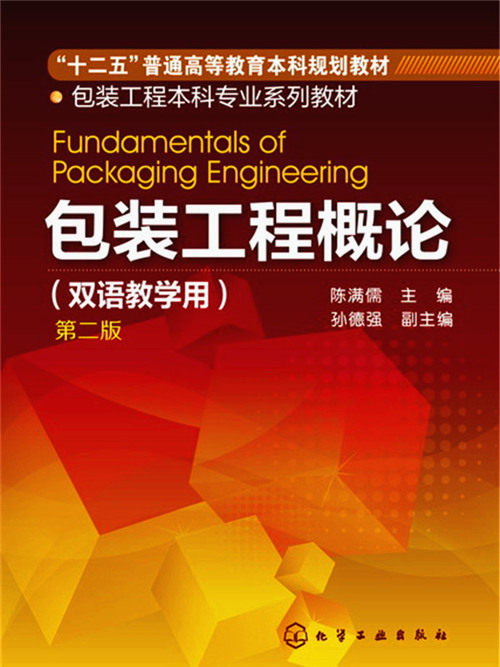《包裝工程概論(第二版)》是2016年4月化學工業出版社出版的圖書,作者是陳滿儒、孫德強。
基本介紹
- 書名:包裝工程概論(第二版)
- 作者:陳滿儒、孫德強
- ISBN:9787122206800
- 頁數:316頁
- 定價:49元
- 出版社:化學工業出版社
- 出版時間:2016年4月
- 裝幀:平裝
- 開本:16開
內容簡介,圖書目錄,
內容簡介
該教材主要包括:Unit 1An Overview of Packaging 包裝概述、Unit 2 Packaging Materials and Containers 包裝材料和容器、Unit 3 Packaging Dynamics and Distribution Packaging 包裝動力學與運輸包裝、Unit 4 Packaging Technology 包裝技術、Unit 5 Packaging Development 包裝研發。
圖書目錄
UNIT 1An Overview Of Packaging1
Lesson 1A Historical Perspective On Packaging1
1What Is Packaging?1
2Primitive Packaging2
3From Rome To The Renaissance3
4The Industrial Revolution5
5The Evolution Of New Packaging Roles6
6Packaging In The 20th Century8
7Modern Packaging9
7.1Changing Needs and New Roles9
7.2Packaging and the Modern Industrial Society9
7.3World Packaging11
8Waste Management And Environmental Issues12
9The Modern Packaging Industry16
Lesson 2Basic Functions of Packaging22
1Introduction22
2The Containment Function23
3The Protection/Preservation Function23
4Food Preservation24
4.1The Nature of Food24
4.2Meat products26
4.3Fish26
4.4Produce26
4.5Barrier Packaging27
4.6Microorganisms28
5The Transport Function35
6The Information/Sales Function36
UNIT 2Packaging Materials And Containers42
Lesson 3Paper and Paperboard42
1Introduction42
2Representative Papermaking Machines42
2.1Fourdrinier machines42
2.2Cylinder Machines43
2.3TwinWire Machines45
3Machine Direction And Cross Direction45
4Surface Or DryEnd,Treatments And Coatings46
5Paper Chracterization47
5.1Caliper and Weight47
5.2Brightness48
5.3Paper and Moisture Content48
5.4Viscoelasticity49
6Paper Types49
6.1Newsprint and Related Grades49
6.2Book Papers49
6.3Commercial Papers49
6.4Greaseproof Papers50
6.5Natural Kraft Paper50
6.6Bleached Krafts and Sulfites50
6.7Tissue Paper50
6.8Label Paper50
6.9Pouch Papers51
6.10Containerboards(linerboard and medium)51
7Paperboard Grades51
7.1Chipboard,Cardboard,Newsboard51
7.2Bending Chipboard51
7.3Lined Chipboard51
7.4Single WhiteLined(SWL)Paperboard52
7.5ClayCoated Newsback(CCNB)52
7.6Double WhiteLined(DWL)Paperboard52
7.7Solid Bleached Sulfate(SBS)52
7.8Food Board52
7.9Solid Unbleached Sulfate(SUS)52
Lesson 4Corrugated Fiberboard Boxes57
1Historical Perspective57
2Corrugated Board58
2.1Construction58
2.2Flutes59
2.3Fiberboard Grades60
2.4Corrugating Adhesives61
2.5Board Manufacture62
3Fiberboard Characterization Tests63
3.1Mullen Burst Test(TAPPI T 810)63
3.2Edgewise Compression Test(TAPPI T 811)63
3.3Flat Crush Test(TAPPI T 808).64
3.4Combined Weight of Facings64
3.5Thickness of Corrugated Board(TAPPI T 411)64
3.6Gurley Porosity(TAPPI T 460 and T 536)64
3.7Flexural Stiffness(TAPPI T 820)64
3.8Water Takeup Tests(TAPPI T 441)64
3.9Puncture Test(TAPPI T 803)64
3.10Pin Adhesion(TAPPI T 821)65
3.11Ply Separation(TAPPI T 812)65
3.12Coefficient of Friction(TAPPI T 815 and ASTM 04521)65
4Corrugated Boxes65
4.1Selecting the Correct Flute65
4.2Box Styles67
4.3Manufacturers joint68
4.4Dimensioning68
5Carrier Rules68
5.1Application68
5.2Summary of Rules for Corrugated Box Construction69
Lesson 5Metal Containers75
1Background75
2Common Metal Container Shapes76
3ThreePiece Steel Cans77
4TwoPiece Cans79
4.1Draw Processes79
4.2DrawandRedraw Process79
4.3DrawandIron Process80
5Impact Extrusion81
6Aerosols83
6.1Aerosol Propellants83
6.2Other Pressurized Dispensers84
Lesson 6Glass Containers89
1Glass Types And General Properties89
2Bottle Manufacture90
2.1Blowing the Bottle or Jar90
2.2Annealing92
2.3Surface Coatings92
2.4Inspection and Packing93
3Bottle Design Features93
3.1Bottle Parts and Shapes93
3.2Finish and Closures94
3.3Neck and Shoulder Areas94
3.4Sides94
3.5Heel and Base95
3.6Stability and Machinability95
3.7Vials and Ampoules95
3.8Carbonated Beverages96
Lesson 7Plastics in Packaging98
1Introduction To Plastics98
2Thermoplastic And Thermoset Polymers100
3Shaping Plastics101
4Plasticating Extruders101
5Extrusion102
5.1Profile Extrusion102
5.2Sheet and Film Extrusion103
5.3BlownFilm Extrusion103
5.4Orientation104
5.5CoExtrusion105
6Injection Molding105
6.1Injection Molding Machines105
6.2Coinjection Molding106
7Extrsion Blow Molding106
8Injection Blow Molding107
9Thermoforming109
9.1Principle and Applications109
9.2Thermoforming Methods109
9.3Billow forming110
10Other Forming Methods111
10.1Pressblowing111
10.2Rotational Molding111
10.3Compression Molding111
10.4BlowFillSeal Molding112
11Recognizing Molding Methods112
Lesson 8Flexible Packaging Laminates116
1Laminates116
2Aluminum Foil 116
2.1Chemical Characteristics117
2.2Aluminum Foil in Flexible Packaging117
2.3Foil Coatings118
3Vacuum Metallizing119
3.1The Metallizing Process119
3.2VacuumMetallizing Paper120
3.3VacuumMetallizing Films120
4Other Inorganic Coating121
4.1Silicone oxides121
4.2Carbon coatings121
4.3Nanocomposites121
5Laminate Structural And Physical Properties121
5.1Coefficient of Friction122
5.2Body and DeadFold Properties123
5.3Tear Properties123
5.4 Thermoformability123
5.5Use Environments123
6Flaxible Bags,Pouches And Sachets123
7Sealability126
8Barrier Properties127
9Laminating Processes129
9.1Bonding Methods129
9.2Laminating Machines129
9.3Coating Stations130
10Specifying Laminates132
Lesson 9Closures138
1Selection Considerations138
2Tamper Evident Closures139
3Tamper Evident Systems140
4ChildResistant Closures142
UNIT 3Packaging Dynamics and Distribution Packaging145
Lesson 10Shock,Vibration,and Compression145
1Shock145
1.1Shock Resulting from Drops145
1.2Shock During Rail Transport147
1.3Other Shock Conditions147
1.4Quantifying Shock Fragility148
1.5Cushioning Against Shock151
2Vibration152
2.1Vibration Damage Due to Relative Motion153
2.2Vibration Resonance153
2.3Stack Resonance154
2.4Isolating Vibration155
3Compression156
3.1Static and Dynamic Compression156
3.2Compression Strength and Warehouse Stack Duration157
3.3Compression Strength and Humidity157
3.4Other Factors Influencing Box Stack Strength157
3.5Contents’ Effect on Compression Strength159
3.6Plastic Bottle Stacking Factors161
3.7Stacking and Compression161
3.8Distribution Environment and Container Performance162
3.9Estimating Required Compression Strength163
Lesson 11Mechanical Shock169
1Introduction169
2The Freely Falling Package169
3Mechanial Shock Theory171
4Shock Duration176
5Shock Amplification And The Critical Element177
6Horizontal Impacts179
Lesson 12Lansmont Six Step Method184
1Step 1 Define The Environment185
1.1Shock Environment185
1.2Vibration Environment187
2Step 2 Product Fragility Analysis188
2.1Shock:Damage Boundary188
2.2Vibration:Resonance Search &Dwell191
3Step 3 Product Improvement Feedback192
4Step 4 Cushion Material Performance Evaluation192
4.1Shock Cushion Performance192
4.2Vibration Cushion Performance193
5Step 5 Package Design194
5.1Shock:Package Design194
5.2Vibration:Package Design195
5.3Package Design Considerations196
6Step 6 Test The Product/package System196
6.1Shock:Package Testing196
6.2Vibration:Package Testing197
Lesson 13Distribution Packaging200
1Short History Of Distribution Packaging In The USA200
2Functions And Goals Of Distribution Packaging200
2.1Containment200
2.2Protection200
2.3Performance200
2.4Communication201
2.5Product Protection201
2.6Ease of Handling and Storage201
2.7Shipping Effectiveness201
2.8Manufacturing Efficiency201
2.9Ease of Identification201
2.10Customer Needs201
2.11Environmental Responsibility201
3The Cost Of Packaging201
4The Package Design Process202
5Taking A Total System Approach To Package Design202
6The Protective Package Concept203
7The 10Step Process Of Distribution Packaging Design205
7.1Identify the Physical Characteristics of the Product205
7.2Determine Marketing and Distribution Requirements205
7.3Learn About the Environmental Hazards Your Packages
will Encounter205
7.4Consider Packaging and Unitizing Alternatives205
7.5Design the Distribution Package205
7.6Determine Quality of Protection Through PerformanceTesting206
7.7Redesign Package(and Unit Load)Until It Successfully
Passes All Tests206
7.8Redesign the Product if Indicated and Feasible206
7.9Develop the Packaging Methods207
7.10Document All Work207
8A Final Check207
9The Warehouse207
10Unit Loads208

